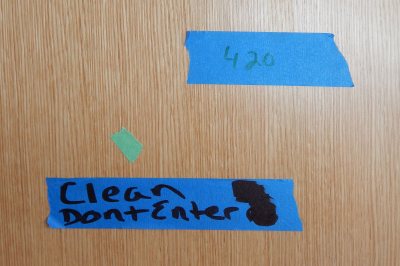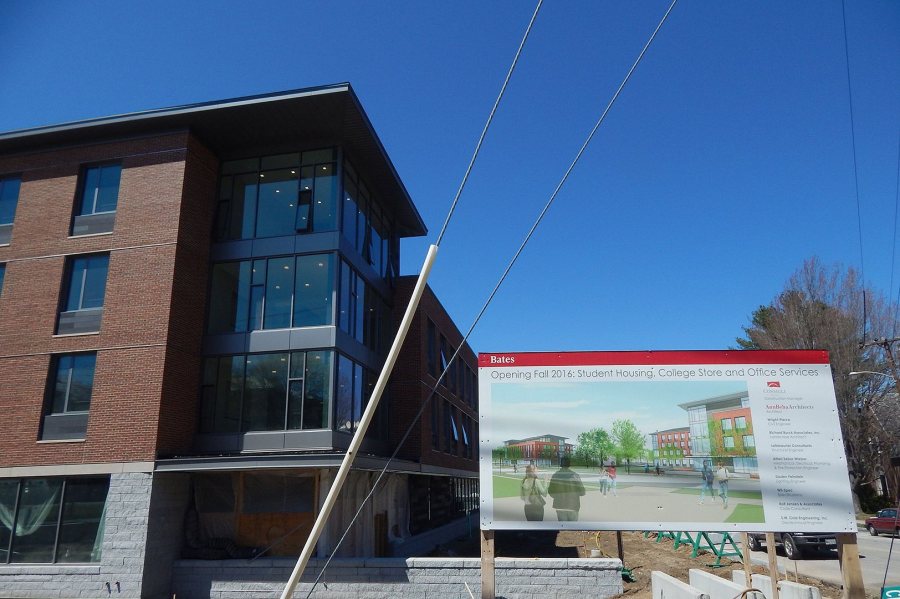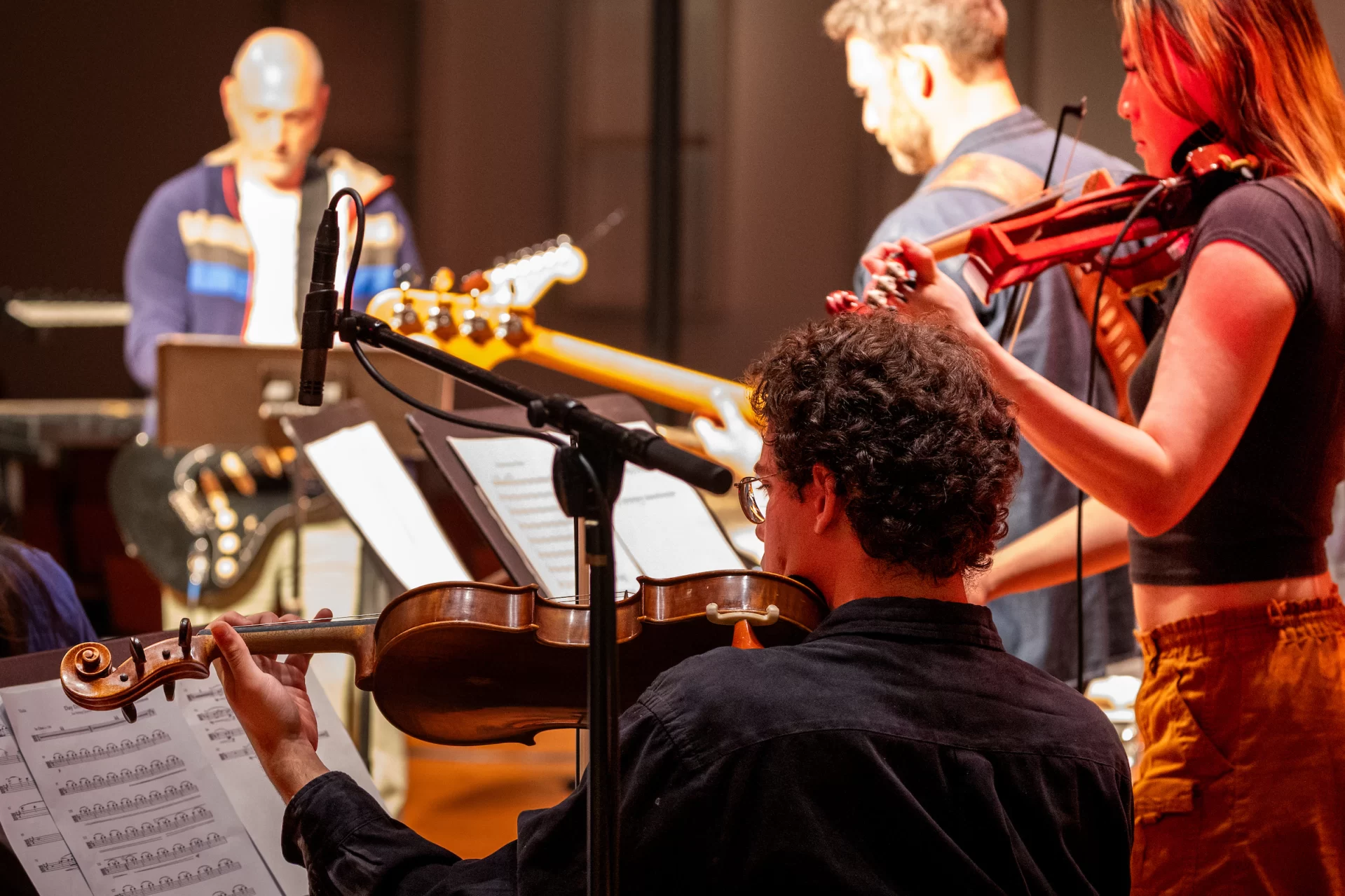
Campus Construction Update: April 29, 2016
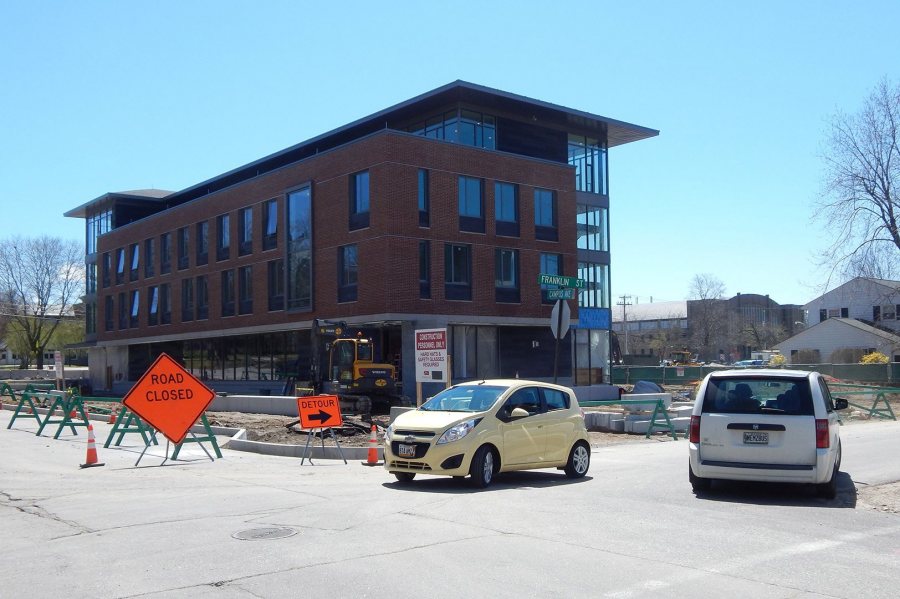
Brief closures of Campus Avenue during April and May 2016 for site work are diverting traffic onto Franklin Street. (Doug Hubley/Bates College)
All right, so New Jersey did not call and ask for its barriers back.
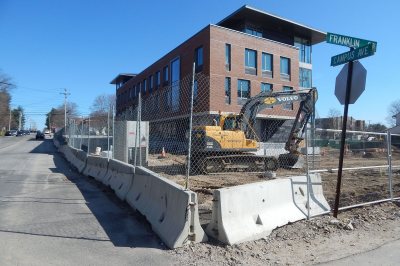
The Jersey barriers and fence were on the way out and Gendron & Gendron was doing site work at 65 Campus on April 15, 2016. (Doug Hubley/Bates College)
But nevertheless, as predicted, the concrete Jersey barriers and attached green construction fence have begun vanishing from the perimeter of the Campus Life Project construction sites. The enclosure around 65 Campus Ave. went away in mid-April, and 55 Campus is losing its fence as this is being written.
Soon both new student residences will be laid bare for all the world to see, or at least as much of the world as happens to be driving down the avenue.
Which, in fact, won’t always be possible in the coming weeks. The Jersey barriers had to go because they’d interfere with the site work that subcontractor Gendron & Gendron is undertaking. And that same site work is also causing occasional closures of the avenue.
Here are just five items on G&G’s to-do list:
- setting spiffy new granite curbing, which has already been completed between Franklin Street and Central Avenue;
- rebuilding the asphalt public sidewalks around the project;
- installing steps and walls, including walls that will enclose a gas grill at each building and granite seating walls reminiscent of the cuboid benches on Alumni Walk;
- grading the ground surface — no mean feat considering the deep ruts carved into the mud by lifts and other heavy equipment during the warm winter;
- and creating two dozen or so drainage features that will handle storm runoff.
We’ve talked about the drainage features before. Their mechanisms and sizes will vary considerably — humble grassy depressions in the landscape; pervious parking lot pavements that will allow water to seep straight down for subterranean treatment; so-called rain gardens, roughly 16 feet wide by 80 long, that will collect and treat water from different sources, etc.
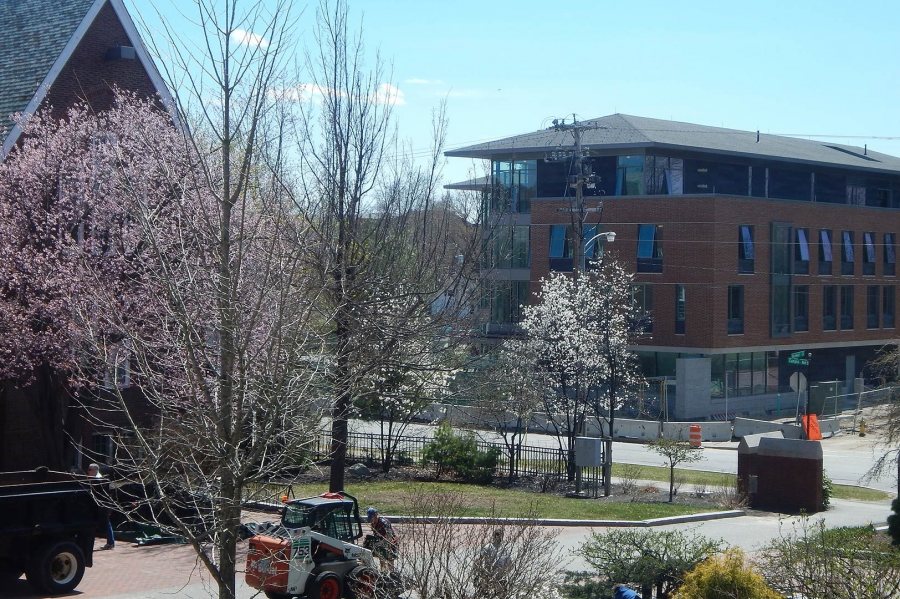
55 Campus Ave. seen through April blossoms from a second-floor window at Carnegie Science. (Doug Hubley/Bates College)
The details may differ, but the features have purposes in common: controlling runoff, cleaning it, and sending it away, whether into municipal storm drains or directly into groundwater. And they share a basic functional approach: ground contours and plastic liners direct the water to layers of soil-like material that filter it before discharge.
“Ultimately we’ll be treating more than 90 percent of the runoff,” says Bates project manager Chris Streifel.
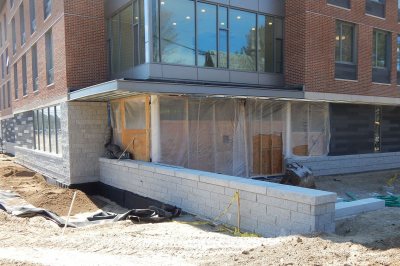
Two dimensions of site work at 65 Campus Ave. on April 25, 2016: plastic sheeting at left that will guide moisture away from the foundation; and a new wall and steps. (Doug Hubley/Bates College)
G&G has finished planting the concrete bases for light fixtures at 65 Campus Ave. The lights themselves, thrifty LED models, should appear in May. Between the two residences, Streifel explains, the fixtures will total some 60 units in four different styles, including funnel-shaped lamps resembling those on Alumni Walk.
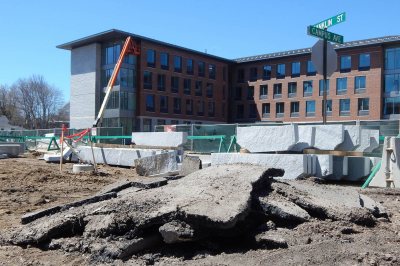
The old and the new: Remnants of an asphalt sidewalk are heaped in front of new granite curbs on April 27, 2015. In the background is 55 Campus Ave. (Doug Hubley/Bates College)
As one of its final chores on this phase of the Campus Life Project, G&G will spread topsoil on the two sites, roughly 1,000 cubic yards of it. That has to wait until there’s no heavy equipment lumbering around the sites that could compact the soil and complicate work for the landscaper, Gammon Landscape Nursery, of Auburn.
As noted in an earlier column, the landscaping may extend past summer and will pretty much close the book on this construction project. But we’ve reported less about the “hardscaping” that will begin more or less simultaneously with the landscaping.

A fourth-floor double, cleaned and punch-listed — as evidenced by the flecks of blue tape — at 65 Campus Ave. on April 26, 2016. (Doug Hubley/Bates College)
Hardscaping is pretty much what it sounds like: the placement of outdoor features made of hard-wearing materials. In June, perhaps the biggest chore that Ellsworth firm Atlantic Landscape Construction will begin is the paving of walkways connecting the two residences. Bricks are the pavers of choice —nice clay bricks, not soulless concrete.
In addition, though G&G is placing the curbs around the site perimeters, Atlantic will set some granite curbing within the grounds. And finally, while we’re talking about hard-wearing materials, Maine Masonry is still on the job, putting granite facades on features started by G&G: stairs, seat walls, gas grill enclosures, etc.
Spring cleaning: It’s a stretch to think of housecleaning as a milestone, but when it’s the first cleaning of a brand-new Bates student residence, that mundane exertion does seem a little more significant.
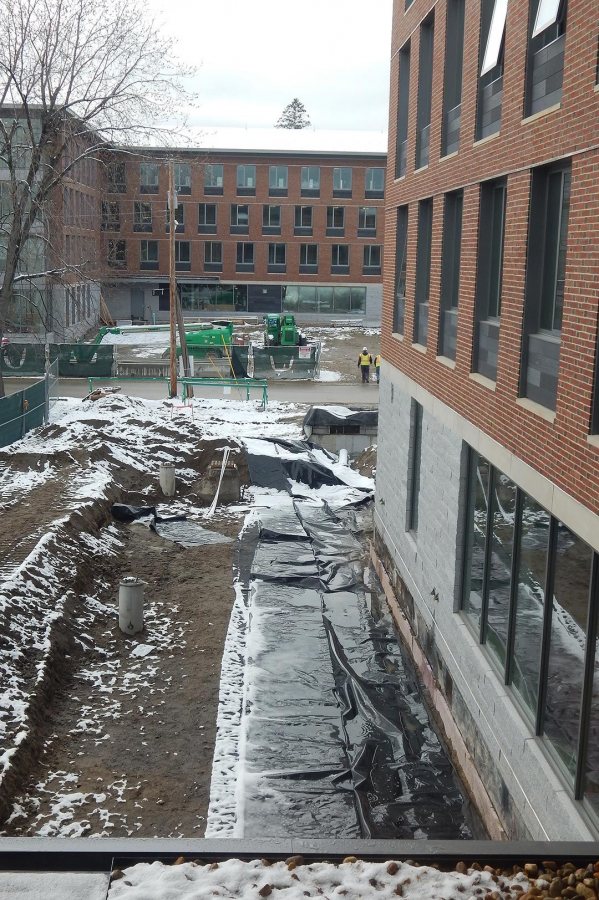
A rain garden seen from the second floor of 65 Campus Ave. on April 26, 2016. The plastic sheeting will divert runoff away from the foundation. The concrete cylinders at left are bases for light poles. (Doug Hubley/Bates College)
Subcontractors at work at 65 Campus Ave. now include Rose’s Commercial Cleaning of Lewiston and the Clean Up Group of Augusta, hired by project construction firm Consigli to make a first pass at now-completed bedrooms and bathrooms on the second, third, and fourth floors. (On the first floor, there’s still considerable finishing work to do in the College Store and Office Services areas.)
Also underway are two other processes that have “endgame” written all over them: punch-listing and commissioning.
These are the same but different. Broadly speaking, each is a painstaking and detailed inspection intended to ensure that the final project looks and works the way it was planned to, back in 2014.
Commissioning is the trial operation of entire infrastructure systems — heating, cooling, electrical, etc. — and is being performed for Bates by Allied Engineering Inc. of Portland, Maine.
At a very rough guess, commissioning at 65 Campus is nearing the halfway mark, but that really constitutes the lion’s share of commissioning because, as Streifel explains, “some of the head-end major systems in 65 service both buildings” — for example, the boilers.
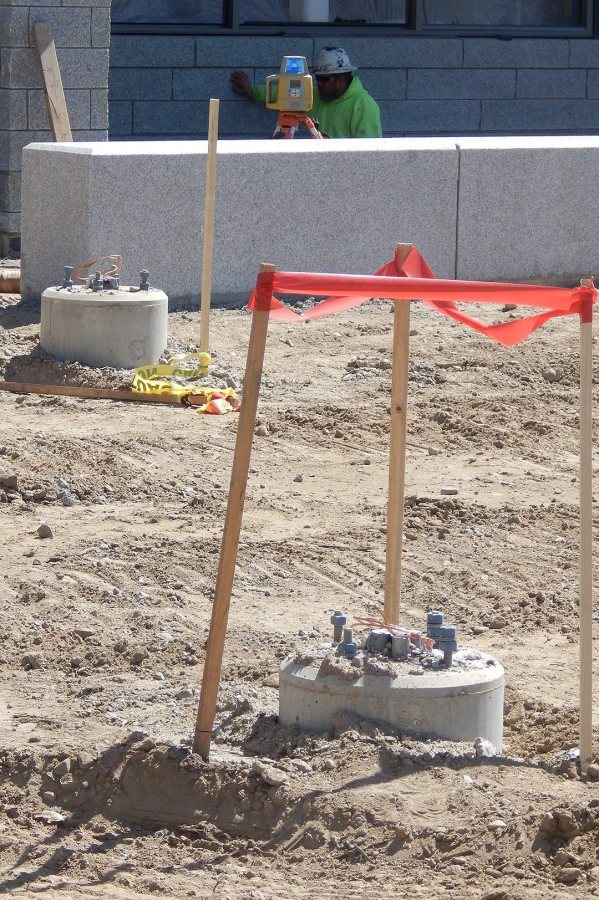
Behind a seating wall, a surveyor (top) works at 65 Campus Ave. on April 25, 2016. The cylindrical projections are light-pole bases. (Doug Hubley/Bates College)
Nevertheless, “there are places in 55 Campus where commissioning could get started,” Streifel adds, so between the two buildings there is plenty to keep Allied busy.
Punch-listing, in contrast, is a process performed by the entire project team and involves all aspects of the construction. So a tour of the residential floors of 65 Campus reveals numerous little patches of blue tape marking spots that need attention — blotchy paint, say, or an oversensitive touchless faucet activator.
“It’s nice to see systems coming on line,” says Streifel. “It’s nice to see truly finished spaces. Some of those student rooms are ready for furniture,” which, he notes, has virtually all been ordered, “and for students.”
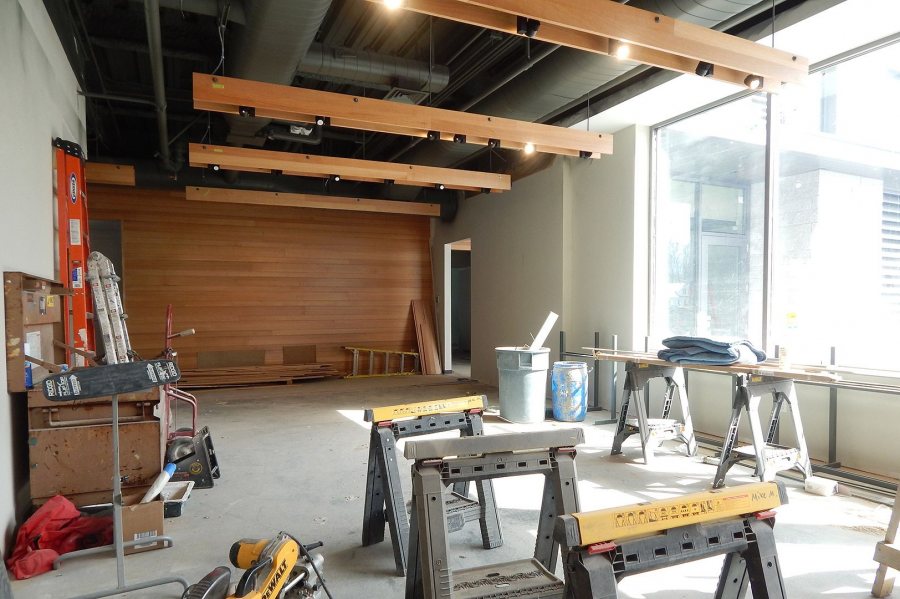
The College Store’s textbook area, photographed in 65 Campus Ave. on April 26, 2016. Note the mellow red-oak veneer, a motif throughout 65 Campus, and the attractive light fixtures. (Doug Hubley/Bates College)
Punch-listing, of course, extends to the building exteriors, and that’s the main reason there are still a handful of workers going up in lifts every day.
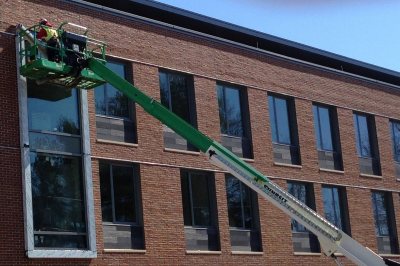
Construction workers on lifts, like this window technician photographed at 55 Campus Ave. on April 15, were a dwindling breed at Bates during spring 2015. (Doug Hubley/Bates College)
But on April 25 and 26 there were also people going up in lifts at night: technicians from the national engineering firm Simpson Gumpertz & Heger Inc., who were using infrared imaging technology to scan both dorms for heat leaks and other undesirable phenomena.
Warm objects emit infrared, so there are scanners, akin to cameras, that depict different temperatures within a given area. And because things cool off at night, the nighttime is the right time (wah-do-day) to go up in a lift and look for precious warmth escaping from a new building: The large temperature differentials provide better contrast in the scans.
Which also gave us another reason to celebrate (not), an April cold snap that brought two inches of much-desired (not) snow to southern Maine on the 26th.
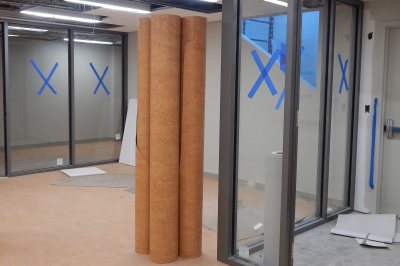
Last tan standing: Linoleum at attention in the Office Services’ mail and printing area — to be known as Post & Print — in the basement of 65 Campus Ave. (Doug Hubley/Bates College)
Speaking of heat, the Campus Avenue dorms passed yet another milestone the week of April 18 as the temporary external heaters that pumped warm air into the buildings all winter were taken away and the buildings’ own heating systems were pressed into service.
Finally, the project team expects that the last of the storefront glass, and the main entrance of 65 Campus, will be in place by the beginning of May.
Can we talk? Campus Construction Update welcomes your questions and comments about current, past, and future construction at Bates. Write to dhubley@bates.edu, putting “Campus Construction” or “Wah-do-day” in the subject line. Or use the 21st-century commenting system below.
